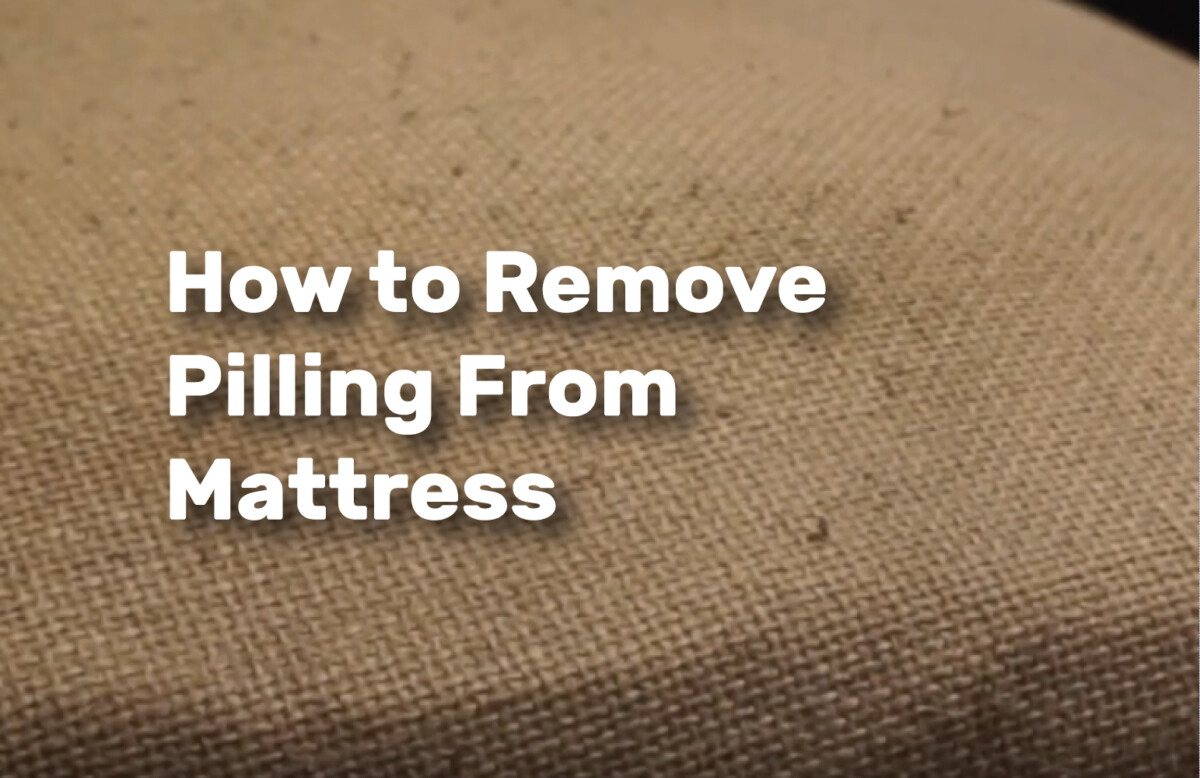Whether you’re looking to buy a new mattress or you already have one, you should be aware of the fact that it may pill up over time. That’s because mattresses are made either with polyester, cotton or wool and these materials can pill up over time, especially if you don’t take care of them properly.
Most mattresses that I’ve come across have a warranty that covers defects for a few years, but that doesn’t do you much good if you find yourself picking mattress fibers off your clothes.
So, how can you remove pilling from the mattress? You can remove pilling from mattress by using a lint roller, a pumice stone or a razor blade.
Pilling is a very common problem among all kinds of fabrics that I have.
Even though pilling on a mattress pad is not as noticeable as it is on other fabrics, I find it quite uncomfortable when I’m sleeping on the mattress.
Here’s a quick overview of what causes mattress pilling and what you can do to remove mattress pilling and have a clean mattress.
What causes mattress pilling?
When you buy a mattress, you expect it to last for many years.
If you follow the proper care instructions, a good mattress will last anywhere from 10 to 15 years.
As the years go by, your mattress will slowly develop some wear.
Eventually, you will notice that pillows and other soft parts of the mattress will start to look worn and old, and you may even see small lumps of fabric where the fabric on the surface of the mattress has worn away.
These are signs of mattress pilling, which occurs when loose fibers on the surface of your mattress start to bunch up and create small lumps.
When you look at a pilled up mattress, the fabric looks like it has little balls of fiber sticking out of it.
This is the mattress protector or cover shredding.
When you sleep, your body weight and skin rubbing against the fabric, the fabric eventually becomes so thin that the threads start separating and become visible.
It is important to remember that some pillows and other sheets can also cause mattress to gather lint, so be sure to keep a close eye on your sheets as well
How to remove pilling from mattress
Piling is almost inevitable in most mattresses over time.
Since not all mattresses come with a warranty, people often try to take care of the problem on their own.
While the process can be rewarding and cost-effective, you must follow all of the right steps to ensure that you can remove the pilling from your mattress completely.
In the past, I used to see people using a vacuum to remove pilling from the mattress.
Vacuuming the mattress helped remove the loose pilling from the mattress, but it didn’t do anything about the pilling that had become ingrained.
While vacuuming does remove some pilling, the hairs from the vacuum can go back into the mattress and create new pilling.
To prevent pilling from occurring in the first place, I think the use of a mattress pad can help.
Mattress pads are available in many different types, including those made of cotton, polyester, and latex.
How to get rid of pilling on mattress
The area of a mattress that’s getting the most wear and tear is the top surface and because of this friction, the fabric tends to pill and create an unsightly appearance.
The good news is getting rid of the pilling on your mattress is easier than you think.
Thankfully, there are a number of techniques for dealing with pilling so that it won’t interfere with the comfort of your mattress.
1. Vacuum to remove the excess
2. Use a lint roller to remove the loose pilling
3. Use a pumice stone to remove the hard pilling
4. Use a razor blade to get rid of larger pieces of pilling
5. Use a damp (but not wet) cloth to remove the last bit of pilling
How can you prolong the life of your mattress?
While it’s not a topic that comes up at parties, my mattress is something I probably spend a considerable amount of time thinking about.
After all, you spend about a third of your life in bed and it can take over a decade to fully break in a new mattress.
Cleaning my mattress isn’t something I do every day.
But, if you have pets or children, you may need to clean up some stains or take a more proactive approach to keeping your mattress lasting longer.
I’ve rounded up some tips on how to clean your mattress, remove stains, and prolong the life of your mattress.
- Use washable covers
- Rotate the mattress regularly
- Use a board that prevents sagging
- Vacuum the mattress regularly
- Get rid of dust mites
- Dry the mattress properly after cleaning
- Protect from dropping items
- Keep the pets off the mattress
Can a bed frame ruin a mattress?
It is very important that the frame that you put your mattress on be supported by a firm, sturdy, and well-built base.
This is because the frame will take a good deal of the stress of the bed and give it to the mattress.
If the frame is of poor quality, then it will be even more likely that the frame will break or wear out before the mattress does.
That could mean a hefty replacement expense, or the need to replace the mattress sooner than expected.
You need a bed frame that can support your mattress, but also allow a breathable gap between the frame and the mattress to let heat and moisture escape, let you get in and out of bed easily, and doesn’t create a tripping hazard or pin you to the bed during the night.
Mattresses can be ruined by moisture and heat.
Mattresses, like all items that come in contact with moisture, degrade over time.
This is because once moisture has been absorbed into the mattress material, it is very difficult to dry out.
This moisture then begins to break down the materials of the mattress, leading to the breakdown of the internal materials and support system.
Even if the mattress is covered in a waterproof cover, it is impossible to keep moisture from coming in through the seams of the cover.
Even worse, moisture that gets trapped between you and your mattress can lead to a host of problems, including mold and mildew growth, odors, stains and even decay.
How often should you change your bed base?
I like to have a nice, clean bed.
I take pride in the fact that our beds are stored in a crisp, fresh, and tidy manner.
But there is one area of your bed that many people forget about—your bed base.
Once you realize how important it is to change your bed base, you will begin to notice how much better you feel when you wake up each morning.
The average life of the average mattress is six to 10 years, but some can last longer than others.
As you change the mattress, new technologies come in to replace the old bed base you’re using, to go with the replacement of the mattress you’re doing.
If you’re wondering when to change your bed base, take a look at your mattress.
If the springs are sagging or you see any indentations, it’s time to upgrade.
We know changing your bed base every few years is a hassle, but if you take the time to change it, you will notice that you sleep better when you wake up in the morning.
A well-made bed base will also support the mattress and can add years to its life.
Happy pilling removal!
A new mattress is a major purchase, and you don’t want to make an impulsive decision and end up hating your mattress a few months later.
If you’ve ever slept on a mattress that’s been worn in by years of use, you’re probably familiar with the phenomenon known as pilling.
Also known as clumping, pilling occurs when loose fibers in a fabric break off and stick together, forming little knots.
Removing pilling from a mattress is something that needs to be done carefully.
This is because of the way the mattress is manufactured.
When the cotton is made into the material, it is covered with a binding agent which keeps the cotton together.
This binding agent has a tendency to come off, and this is what is called the pilling.
Removing pilling from the mattress requires a little work, but it is far from impossible.
You can use a few different methods to do this.
One is using a lint roller. This will work on smaller mattresses.
You can also use a razor blade to get rid of larger pieces of the fiber that are pilling.




